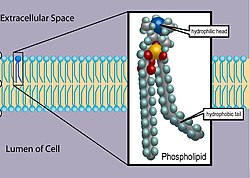Search results
Appearance
There is a page named "Phosphocholine" on Wikipedia
- Glycerol 3-phosphocholine)L-α-Glycerophosphorylcholine (alpha-GPC, choline alfoscerate, sn-glycero-3-phosphocholine) is a natural choline compound found in the brain. It is also a parasympathomimetic...7 KB (615 words) - 19:00, 20 March 2025
Cytidine 5'-phosphocholine)
citicoline by the rate-limiting enzyme in phosphatidylcholine synthesis, CTP-phosphocholine cytidylyltransferase. Studies suggest, but have not confirmed, potential...
19 KB (1,892 words) - 11:46, 7 May 2025
stable pentameric structure with a discoid shape. CRP binds to the phosphocholine expressed on the surface of bacterial cells such as pneumococcus bacteria...
48 KB (5,497 words) - 07:42, 15 April 2025
2-acylglycero-3-phosphocholine)
position of phosphatidylcholine. They are also called 2-acyl-sn-glycero-3-phosphocholines. The synthesis of phosphatidylcholines with specific fatty acids occurs...
25 KB (2,167 words) - 09:50, 24 May 2025
ceramide. Other common groups bonded to the terminal oxygen atom include phosphocholine, yielding a sphingomyelin, and various sugar monomers or dimers, yielding...
25 KB (2,774 words) - 01:24, 26 May 2025
1-acylglycerol-3-phosphocholine
) Precursors Choline ATP Phosphocholine PC LPC AAG...
11 KB (1,140 words) - 01:10, 25 May 2025
Sn-glycero-3-phosphocholine glycerophosphohydrolase)
phosphodiesterase (EC 3.1.4.2) catalyzes the reaction sn-glycero-3-phosphocholine + H2O ⇌ {\displaystyle \rightleftharpoons } choline + sn-glycerol 3-phosphate...
2 KB (131 words) - 14:21, 26 August 2023
route, cytosolic choline kinases (CK) phosphorylate choline with ATP to phosphocholine (PChol). This happens in some cell types like liver and kidney. Choline-phosphate...
60 KB (6,049 words) - 22:39, 3 June 2025
POPC (1-palmitoyl-2-oleoyl-sn-glycero-3-phosphocholine) is a phosphatidylcholine. It is a diacylglycerol phospholipid. It is an important phospholipid...
2 KB (98 words) - 13:18, 12 November 2023
1,2-Distearoyl-sn-glycero-3-phosphocholine)
SM-102 DMG-PEG 2000 Others Stearic acid, contributing stearoyl- group Phosphocholine van Hoogevest P, Wendel A (2014). "The use of natural and synthetic...
4 KB (262 words) - 20:37, 29 May 2025
Abbreviation CAS Name Type DDPC 3436-44-0 1,2-Didecanoyl-sn-glycero-3-phosphocholine Phosphatidylcholine DEPA-NA 80724-31-8 1,2-Dierucoyl-sn-glycero-3-phosphate...
26 KB (2,029 words) - 07:34, 30 June 2025
Acyl-CoA:1-alkyl-sn-glycero-3-phosphocholine O-acyltransferase
) + 1-alkyl-sn-glycero-3-phosphocholine ⇌ {\displaystyle \rightleftharpoons } CoA + 2-acyl-1-alkyl-sn-glycero-3-phosphocholine Thus, the two substrates...
2 KB (180 words) - 12:22, 26 August 2023
1-organyl-2-acyl-sn-glycero-3-phosphocholine:1-organyl-2-lyso-sn-glycero-3-phosphoethanolamine acyltransferase (CoA-dependent)
) that catalyzes the chemical reaction 1-organyl-2-acyl-sn-glycero-3-phosphocholine + 1-organyl-2-lyso-sn-glycero-3-phosphoethanolamine ⇌ {\displaystyle...
2 KB (252 words) - 14:21, 26 August 2023
Acyl-CoA:1-acyl-sn-glycero-3-phosphocholine O-acyltransferase)
acyl-CoA + 1-acyl-sn-glycero-3-phosphocholine ⇌ {\displaystyle \rightleftharpoons } CoA + 1,2-diacyl-sn-glycero-3-phosphocholine Thus, the two substrates of...
3 KB (300 words) - 12:22, 26 August 2023
- choline. English Wikipedia has an article on: phosphocholine Wikipedia phosphocholine (plural phosphocholines) (organic chemistry) The choline ester of phosphoric
- N-(dimethylammonio) butyrate • DMPC, 1,2 Dimytristoyl-sn-glycerol-3-phosphocholine • GpA, glycophorin A • MS1, QLLIAVLLLIAVNLILLIAVARLRYLVG • L7NL11, RARL7NL11GILIN
)




